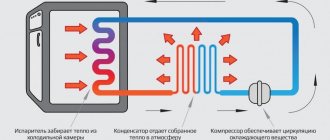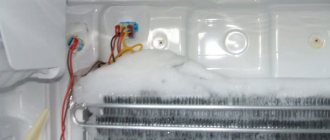The refrigerator is the only household electrical appliance that independently maintains operating condition around the clock. Therefore, you need to know what power the refrigerator has, what energy saving class it belongs to and how much energy it consumes per month. The amount of your monthly electricity bill will largely depend on these indicators.
Energy efficiency classes
Since the early 2000s, the eco-movement has become popular, fighting for the preservation of natural resources and a clean environment. Thanks to this trend, world leaders in the production of household appliances have developed and implemented technologies that save resource consumption. The changes affected large household appliances, such as washing machines, dishwashers, refrigerators, microwave ovens, and vacuum cleaners. In the latest models, the developers have managed to reduce the energy consumption of the refrigerator to a minimum.
In July 2014, the current regulation on the classification of energy efficiency of refrigerators was adopted, and it is uniform for all countries of the world. Each class has its own energy efficiency index, which is calculated using a complex formula and expressed as a percentage of the energy consumption rate.
Refrigerators are divided into the following classes based on the principle of energy consumption:
- A+++ - the most economical option with an index of 10-15%;
- A++ - consumes up to 30%;
- A+ - consumes from 30 to 42%;
- A - eats from 42 to 50%;
- B - from 55 to 75%;
- C - class economy below average, consumption from 75 to 90%;
- D - saves a minimum of energy, consumes from 90 to 100%;
- E - spends more than necessary (from 100 to 110%);
- F is the most energy-consuming class with an index from 110 to 125%.
The most popular are refrigerators that belong to class A and higher.
Equipment with energy consumption classes E and F is practically not produced (this includes all old models).
To determine how much kW a refrigerator consumes per day, just read the equipment passport or find the consumption class designation on a tag or sticker.
How to reduce consumption?
The tips below will not reduce consumption completely, but will slightly reduce the indicator, and will also help the device last a long time and prevent the possibility of failure:
- Do not install the device close to walls. A minimum 10cm distance between the back panel and the wall will ensure sufficient air circulation.
- Do not place near heating elements. The heat from the appliances will heat the walls of the refrigerator and the radiator.
- Maintain optimal temperatures: from +4 in the refrigerator and -4 in the freezer. You can manually set higher values, but energy costs will increase.
- Do not keep the doors open for a long time, and also check that they are closed tightly.
- Do not place hot food on shelves, even for short periods of time and for the purpose of cooling.
- Check the condition of the rubber bands along the contours of the doors. Over time, they fail, begin to lag and allow air to pass through, which causes defrosting.
- Carry out routine cleaning of the drain hole.
- Clean the rear panel where the radiator grill is located from dust using a vacuum cleaner or brush.
- If a breakdown occurs, call a specialist; do not try to repair it yourself.
What does consumption depend on?
Electricity consumption depends on a number of factors. One of them has already been discussed above - the resource consumption class. Other important indicators affecting power and electricity consumption include:
- volume of refrigerator and freezer;
- dry freezing function;
- compressor power;
- ice maker function;
- presence of a second compressor;
- quality of sealing materials;
- backlight, electronic clock and similar functions;
- maintained temperature inside the chamber.
These are the main factors that affect the energy consumption of a refrigerator. Experts identify several more indirect factors that do not depend on the model and class of equipment. These include:
- frequency of opening the refrigerator;
- temperature in the room: the higher it is, the more often the compressor turns on.
It should be remembered that it is not recommended to place refrigeration equipment next to an oven, stove, microwave and other heating appliances.
Refrigerator compressor and power
It is not for nothing that the compressor is considered the main part of refrigeration units. The normal functioning of the unit, in particular the quality of freezing, largely depends on it. The compressor accounts for a significant portion of the energy consumption of the refrigerator. Therefore, the compressor requires careful care and regular maintenance. In this case, the quality of the device and its service life are significantly increased.
Compressor power in watts and electricity consumption may vary depending on the volume of the refrigeration chamber and its load. The presence of one or more cameras is of great importance. For example, in a single-chamber refrigerator, one compressor is enough, but in a two-chamber refrigerator, two are required. It is quite natural that in the second case, electricity consumption almost doubles. In practice, as already noted, this figure may be even higher than indicated in the technical documentation.
It is necessary to periodically check the condition of the electrical network from which power is supplied to the compressor. In the event of voltage drops downward, the compressor will not develop the specified power. With a sharp increase in current, the device turns on at full power and consumes much more electricity. Under such conditions, the service life of the compressor is also reduced. Therefore, during operation, it is recommended to connect the refrigerator to the network through stabilizing devices.
What is affected by power consumption?
The average power consumption of a refrigerator affects not only the functionality of the appliance, but also the monthly payment for electricity. Before buying a refrigerator, it is important to study all its capabilities and resource costs so as not to overpay for unnecessary parameters and excessive energy consumption. When choosing a refrigerator, it is important to pay attention to the following criteria:
- How many kg does the camera freeze per day with average energy consumption? If there is more product in the refrigerator than is written in the passport, then the cost of resources for freezing will increase. Conversely, if less space is used regularly, some of the electricity will be wasted.
- The presence of additional functions such as quick freezing, ice maker, dry freezing, etc. Such functions significantly increase the overall energy consumption. If you can do without them, it is better to choose a simpler model.
- Energy efficiency class. It is optimal to choose class A and higher. Average energy consumption is about 35-40 W/hour, and the total savings will increase to 35%.
Maximum power consumption of the refrigerator
Peak loads of energy consumption are an important passport indicator. The cross-section of the electrical wiring is calculated for it. In the linear compressor, increased loads arise during the start-up period, and they are taken into account when determining how many watts the maximum power of the refrigerator is.
But it’s not just the compressor that affects peak loads. The electrical power of a refrigerator is an indicator that shows how much energy is spent over a certain period of time to preserve food in a given mode. It can be reduced by setting a higher temperature using low-fill mode control. The refrigerator engine will operate at lower power as the load decreases.
How to calculate consumption
All information about the power and resource costs of the refrigeration unit is indicated in the technical passport. Most often, consumption information is located in the energy saving section and is indicated in kWh/year. Knowing these data, it will not be difficult to calculate how much the refrigerator consumes per month, per day, and even per hour. You just need to perform a few simple mathematical operations.
For example, there is an A++ class refrigerator with a consumption of 220 kWh/year. To find out the monthly resource consumption: 220/12=18.3 kWh. We calculate the daily consumption in the same way: 220/365 = 0.603 kW. You can find out how much the refrigerator consumes per hour in watts: (0.603/24)*1000=25.25 W.
All calculations show average values and may change under the influence of various factors. Also, the calculations do not take into account engineering error.
Comparison with other household appliances
It is believed that large household appliances consume more electricity than small ones. But it is not always the case. Energy consumption depends on the power of the device and its operating time.
If we compare average values, refrigeration equipment with a high energy saving class will be more economical than many other kitchen units. For example, a standard 2 kW electric kettle uses about 28 kWh monthly. A class A refrigerator is about 19 kWh. If you use a computer 3-4 hours a day, then up to 60 kWh will be used up in a month. The consumption of a washing machine will be approximately the same.
Main factors affecting power consumption
The total amount of power consumed is influenced by technical and organizational factors. The former depend on the design and technical characteristics of the refrigeration unit. The second - from the correct operation.
The first include:
- The internal space of the refrigerator, the number and volume of chambers, the presence of a separate freezer. All these factors determine the total power of the unit. It has been experimentally proven that a refrigerator with a volume of 500 liters consumes approximately 520 kW/h of electricity throughout the year. The larger the volume, the more electricity required. However, even large-sized equipment can be quite economical and belong to a high energy consumption class.
- Quality and reliability of thermal insulation. It protects the interior of refrigeration chambers from the penetration of warm air in the room. This indicator is determined by the thermal conductivity coefficient of insulating materials. The higher it is, the more reliably the required temperature is maintained inside. Accordingly, electricity is saved to create the necessary temperature conditions.
- Any additional function improves the consumer properties of the refrigeration unit. This leads to an increase in the number of structural elements, and, consequently, increases energy costs. The only function that is designed to reduce this indicator is the “Vacation” function. It allows you to maintain zero temperature inside all chambers during the entire period marked as vacation, when the owners are away from home for a long time.
- Availability of special systems for freezing products without the formation of ice. These include: No Frost, Frost Free, Total Frost. All of them require additional electricity consumption. This is due to the fact that fans periodically turn on to blow the evaporator and motors to pump the coolant.
- Power of compressors, heaters and fans installed in the device.
- Availability and periodic activation of the ice maker function.
- Sealing of refrigerator and freezer compartments.
How much electricity does a refrigerator consume?
The design of modern household appliances is aimed at maximizing savings in consumed resources. They take into account not only the operating time and power of the equipment, but also the degree of load of the device, energy efficiency class, and the presence of additional functions.
Some brands of refrigeration equipment use a value in liters instead of a letter version of the energy capacity class designation. In this case, the calculation of consumed electrical energy is even simpler: take 1 kW per 1 liter of volume. So, for a refrigerator marked 250 liters, the consumption will be about 250 kW per year.
Lg
New models of LG refrigeration equipment belong to the A++ energy efficiency class, which allows owners to save up to 38% compared to other types of refrigerators. The equipment is equipped with an inverter linear compressor, thanks to which the refrigerator consumes electricity per hour from 25 to 32 W.
Liebherr
Liebherr is a world-famous manufacturer of refrigeration and freezing equipment. The popularity of the products is due to high build quality, ease of use, combination of stylish design and reliability. The big advantage of the latest models is the economical power consumption of the refrigerator, which is less than 1 kW per day.
Biryusa
Biryusa - compact and functional refrigeration units of domestic production. Models available in various sizes and purposes. All units have a 3 year warranty. The latest line of equipment belongs to energy efficiency class A - an average-sized refrigerator consumes about 1000 watts per day.
Indesit
Indesit refrigeration equipment is distinguished by a combination of stylish design, high build quality, and durability. All modern models can save up to 35% of electricity. For an average refrigerator, power consumption ranges from 260 to 330 kW/year.
Atlant
Atlant refrigeration equipment is in demand due to the reliability and versatility of its models. The range includes devices capable of freezing from 6 to 20 kg of food. At the same time, the electricity consumption of a refrigerator of average volume and functionality does not exceed 360-400 kW per year. The exception is models with No Frost technology (energy consumption increases significantly).
Impact of Energy Consumption on Refrigerator Performance
This refrigeration equipment parameter affects the following characteristics of the device:
- energy efficiency;
- freezing power;
Energy efficiency determines how efficiently a refrigerator uses electricity while it is operating.
As an example, consider the energy efficiency of the GORENJA OBRB 153 R class A+++ refrigerator and the Bosch KGE 39 XW 20 R.
The power by GORENJA OBRB 153 R daily consumption is 336 W. With this amount of energy consumed, the annual consumption will be 123 kW.
The power consumed by the Bosch KGE 39 XW 20 R per hour is 34 W, and the daily consumption is 816 W, and the annual consumption is 298 kW.
From this we can conclude that the GORENJA OBRB 153 R is 59% more efficient than the Bosch KGE 39 XW 20 R. Accordingly, choosing the former will be more economical in the future.
Freezing power is a parameter that determines the capacity of the refrigeration chamber and the amount of food that it can freeze during the day down to -18°C. It is measured in kg.
The freezing capacity of the equipment, as well as the energy efficiency class, is indicated on the information sticker. It is designated as "X***". For a standard family of up to 4 people, the average freezing capacity is about 12 kg/day.
For clarity, let’s look at the freezing ability of refrigerators from some popular brands:
- Bosch KAD 62 S 220 – capacity up to 12 kg/day;
- Samsung RB33J3420BC - 12 kg/day;
- Liebherr T 1414 – 2 kg/day.
It should be taken into account that the presence of additional functions also affects the increase in energy consumption, for example, acceleration of freezing or self-freezing mode.
How to save energy?
The popularity of energy-efficient household appliances is growing every year. Therefore, refrigerator manufacturers are looking for new methods to reduce resource consumption. You cannot force a refrigerator to consume less than what is indicated in the standard table of the technical data sheet. However, losses can be kept to a minimum. Most often, to reduce power consumption they use:
- improvement of the compressor control system;
- ergonomic arrangement of chambers and storage areas of a two-chamber apparatus;
- increasing the reflective properties of the body.
If a two-chamber unit meets all the characteristics described above, but consumes more energy than indicated in the passport, operational errors are possible.
There are a number of tips that will help reduce the amount of energy consumed:
- You should open the refrigerator as little as possible and keep the door open as little as possible. This will help reduce the load on the compressor.
- Cover liquid foods with a lid. The liquid evaporates, so the evaporator works harder, which increases resource costs.
- Do not set minimum temperatures unnecessarily. A lot of energy will be wasted.
- Do not place warm or hot food in the refrigerator compartment.
- It is best to place products evenly throughout the chamber. This will ensure normal air circulation and will not require additional electricity costs.
- Monitor the sealing properties of the seals. Over the years, they wear out, which leads to loss of cold, and this, in turn, causes increased energy consumption.
- Do not place the refrigerator near a stove, oven, radiator or other heating appliance.
- The ventilation hole should not fit tightly against the wall or objects.
- Disconnect the refrigerator from power as little as possible. The peak energy consumption occurs when starting the refrigerator (150-200 W per hour with a starting current of several amperes).
By following these recommendations, you can further save up to 8% in hours of consumption per year from standard electricity consumption.
How to choose an economical model
Which refrigerator is the most economical is determined from the technical documentation; the characteristics of the internal systems of household appliances are also taken into account.
We buy a refrigerator taking into account the following device parameters that affect energy consumption:
- compressor power;
- number of chambers and their volume;
- cooling system characteristics;
- degree of tightness;
- current strength (in amperes);
- characteristics of additional options.
View » Where LG two-chamber refrigerators with No Frost technology are assembled: country of origin, overall dimensions, best models
For modern refrigeration equipment, the presence of a display, super freezing mode, etc. will increase the amount of energy consumption.
Manufacturers produce models with 1-2 compressors. Devices with 2 compressors have more modes, quickly cool food and consume more electricity. Inverter compressors are economical in this regard. These devices quickly reduce the temperature and maintain a stable temperature without large expenditures of electricity; the power is smoothly regulated.
Inverter devices operate without heavy loads on the electrical network and operate almost silently.
Classic refrigerators have a step system and during operation use all the power to lower the temperature and maintain it.
How much the refrigerator consumes is also determined by the cooling system, which can be drip or NoFrost. A drip-type system is more economical; NoFrost technology is more energy-consuming, but ensures comfortable use of household appliances.
For a family of 3-4 people, a two-chamber refrigeration unit is recommended. Models with 1 compartment with a flow rate of 220 kW are used in small spaces. The level of energy consumption depends on the number of chambers and the volume of the refrigerator. A two-chamber unit consumes a little more electricity than a single-chamber unit, while the model with 2 chambers is the most efficient in terms of capacity.
High-quality insulation is airtight and ensures cold retention, reducing energy loss. When the tightness of the equipment is low, energy consumption increases due to the high load on the compressor. Trusted brands produce high-quality equipment with low and medium energy consumption.
Energy consumption can be minimized through improvements to the engine management system, ergonomic chambers and storage areas. This indicator is also reduced by the increased reflective properties of the device body.
It is recommended to open the refrigerator less often to minimize energy consumption. Do not place warm foods or hot dishes in the freezer. The products are distributed evenly in the refrigerator for stable air circulation.
It is recommended to check the tightness of the seals. The material wears out during operation, which leads to loss of tightness of the structure. Do not install the refrigeration unit next to an electric stove, oven, radiator or other heating appliances. It is recommended that you disconnect the equipment from the power supply less frequently. By taking these recommendations into account, you can save up to 8% of the total amount of electricity.
I am an energy company bill payer
The case is simple, and manufacturers are counting on it. To this end, the European Union passed a law about 15 years ago obliging manufacturers to clearly label the electricity consumption of household appliances. A label is present on the appliances, showing the consumption of the refrigerator per day or year. The average value allows you to quickly calculate the consumption of the refrigerator.
The main consumer of electricity in a refrigerator is the compressor. The energy consumption class of the refrigerator was graded from the letter A to G, in order of worsening characteristics. Manufacturers began to produce equipment with parameters better than first class. The following designations have come into use:
- A+.
- A++.
- A+++.
A plus means energy savings relative to class A by 10%, two pluses - 30%, three pluses - 50%. Please note that the figures are highly averaged; in fact, there are entire ranges of values that the power consumption of the refrigerator can accept. Do not think that the two A+ devices have no differences. Today, a refrigerator worse than A+ is considered unpromising. By the way, class D is considered the standard, and refrigerators marked with the letter A should spend no more than 55% of this value.
Typical consumption for such models is 400 kWh/year. It’s easy to calculate - it will come out within a thousand rubles. In fact, the figure depends on the displacement of the equipment. Exact formulas for calculation will not help much, just understand that the energy consumption of a refrigerator of significant dimensions, class A+, is sometimes higher than that of a small appliance with the letter A. The label, as a rule, has two values - annual and daily. For refrigerators with two compressors, the parameters are indicated for the engines separately or in total.
Buyers are interested in freezing power. Let's take this opportunity to tell you. Those who think: we are talking about obtaining ice, and the figure of 20 kg/day means that this solid substance will be obtained at the output, are mistaken. In fact, the measurement takes place on special plastic bags weighing 1 kg, 500 and 125 g in the shape of a parallelepiped. An incredible liquid consisting of four components is poured inside. Let's try to describe the mixture:
- Water - 75%.
- Emulsifier with an unpronounceable name - 20%.
- Salt - 5%.
- Antiseptic - 1%.
What happens next depends on the climate class. For refrigerators N, tests are carried out at a temperature of 32ºС, the bags are maintained under the same conditions. For a tropical climate (T), the external environment should have a temperature of 43ºC. The bags are placed in refrigerators and freezers, where the objects must freeze. In refrigerators up to +5ºС, in freezers – up to minus 18ºС. The packages are placed in a special way, without touching each other. To understand that the liquid has reached the set temperature, a special sensor is placed inside.











